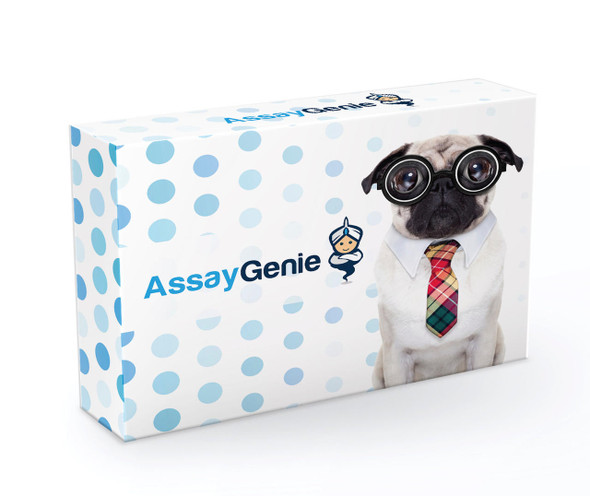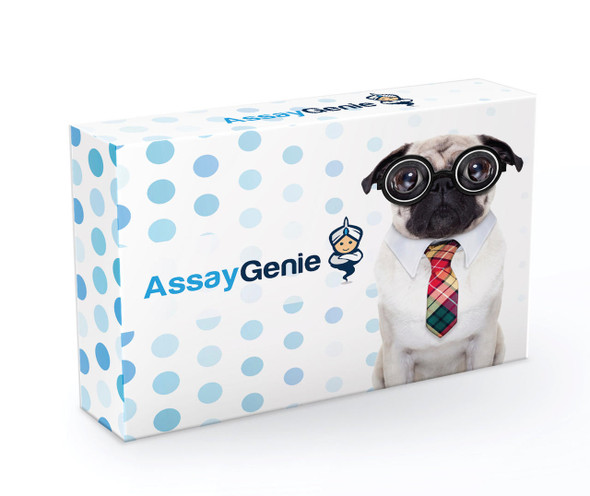Ovalbumin-specific IgE refers to immunoglobulin E (IgE) antibodies that are specifically produced in response to ovalbumin, a major protein found in egg whites. The Mouse Ova sIgE kit allows researchers to gain valuable insights into the immune response to ovalbumin and the development of allergies in mice.
Description
Mouse Ovalbumin Specific IgE / OVA sIgE ELISA Kit
Key Features
| Save Time | Pre-coated 96 well plate | |
| Quick Start | Kit includes all necessary reagents | |
| Publication Ready | Reproducible and reliable results |
Overview
| Product Name: | Mouse Ovalbumin Specific IgE / OVA sIgE ELISA Kit |
| Product Code: | MOFI01017 |
| Size: | 96 Assays |
| Alias: | OVA sIgE |
| Detection Method: | Indirect ELISA - HRP |
| Application: | .This immunoassay kit allows for the in vitro quantitative determination of Mouse OVA sIgE concentrations in serum plasma and other biological fluids |
| Sensitivity: | 0.938ng/ml |
| Range: | 1.563-100ng/ml |
| Storage: | 4°C for 6 months |
| Note: | For Research Use Only |
Additional Information
| Recovery | Matrices listed below were spiked with certain level of Mouse OVA sIgE and the recovery rates were calculated by comparing the measured value to the expected amount of Mouse OVA sIgE in samples.
| ||||||||||||||||||||
| Linearity: | The linearity of the kit was assayed by testing samples spiked with appropriate concentration of Mouse OVA sIgE and their serial dilutions. The results were demonstrated by the percentage of calculated concentration to the expected.
| ||||||||||||||||||||
| Intra Assay | CV < 8% | ||||||||||||||||||||
| Inter Assay | CV < 10% |
Kit Components
| Component | Quantity | Storage |
| ELISA Microplate (Dismountable) | 8x12 strips | 4°C for 6 months |
| Lyophilized Standard | 2 | 4°C/ -20°C |
| Sample/Standard Dlution Buffer | 20ml | 4°C |
| HRP-labeled Antibody (Concentrated) | 120ul | 4°C (Protection from light) |
| Antibody Dilution Buffer | 10ml | 4°C |
| TMB Substrate | 10ml | 4°C (Protection from light) |
| Stop Solution | 10ml | 4°C |
| Wash Buffer (25X) | 30ml | 4°C |
| Plate Sealer | 5 | - |
Other materials required:
- Microplate reader with 450 nm wavelength filter
- Multichannel Pipette, Pipette, microcentrifuge tubes and disposable pipette tips
- Incubator
- Deionized or distilled water
- Absorbent paper
- Buffer resevoir
Protocol
*Note: Protocols are specific to each batch/lot. For the exact instructions please follow the protocol included in your kit.
| Step | Procedure |
| 1. | Set standard, test sample (diluted at least 50% with Sample Dilution Buffer) and control (blank) wells on the pre-coated plate and record their positions. It is recommended to measure each standard and sample in duplicate. Wash plate 2 times before adding standard, sample and control (blank) wells! |
| 2. | Aliquot 100µL of standard solutions into the standard wells. |
| 3. | Add 100µL of properly diluted Sample into the sample wells. |
| 4. | Seal the plate with a cover and incubate at 37 °C for 90 mins. |
| 5. | Wash: Repeat the aspiration/wash process for 3 times. |
| 6. | HRP-labelled antibody: Add 100µL of HRP-labelled antibody working solution into the bottom of each well (standard, test sample & zero wells) without touching the side walls. |
| 7. | Seal the plate with a cover and incubate at 37°C for 30 mins. |
| 8. | Wash: Remove the cover, and wash plate 5 times with Wash buffer. |
| 9. | TMB Substrate: Add 90 µL of TMB substrate into each well, cover the plate and incubate at 37°C in dark for 10-20 mins. (Note: This incubation time is for reference only, the optimal time should be determined by the end-user.) As soon as a blue colour develops in the first 3-4 wells (with most concentrated standards) and the other wells show no obvious colour, terminate the reaction. |
| 10. | Add 50µL of Stop solution into each well and mix thoroughly. The colour changes into yellow immediately. |
| 11. | Read the O.D. absorbance at 450 nm in a microplate reader immediately after adding the stop solution. |
Sample Type
When carrying out an ELISA assay it is important to prepare your samples in order to achieve the best possible results. Below we have a list of procedures for the preparation of samples for different sample types.
| Sample Type | Protocol |
| Serum | If using serum separator tubes, allow samples to clot for 30 minutes at room temperature. Centrifuge for 10 minutes at 1,000x g. Collect the serum fraction and assay promptly or aliquot and store the samples at -80°C. Avoid multiple freeze-thaw cycles. If serum separator tubes are not being used, allow samples to clot overnight at 2-8°C. Centrifuge for 10 minutes at 1,000x g. Remove serum and assay promptly or aliquot and store the samples at -80°C. Avoid multiple freeze-thaw cycles. |
| Plasma | Collect plasma using EDTA or heparin as an anticoagulant. Centrifuge samples at 4°C for 15 mins at 1000 × g within 30 mins of collection. Collect the plasma fraction and assay promptly or aliquot and store the samples at -80°C. Avoid multiple freeze-thaw cycles. Note: Over haemolysed samples are not suitable for use with this kit. |
| Urine & Cerebrospinal Fluid | Collect the urine (mid-stream) in a sterile container, centrifuge for 20 mins at 2000-3000 rpm. Remove supernatant and assay immediately. If any precipitation is detected, repeat the centrifugation step. A similar protocol can be used for cerebrospinal fluid. |
| Cell culture supernatant | Collect the cell culture media by pipette, followed by centrifugation at 4°C for 20 mins at 1500 rpm. Collect the clear supernatant and assay immediately. |
| Cell lysates | Solubilize cells in lysis buffer and allow to sit on ice for 30 minutes. Centrifuge tubes at 14,000 x g for 5 minutes to remove insoluble material. Aliquot the supernatant into a new tube and discard the remaining whole cell extract. Quantify total protein concentration using a total protein assay. Assay immediately or aliquot and store at ≤ -20 °C. |
| Tissue homogenates | The preparation of tissue homogenates will vary depending upon tissue type. Rinse tissue with 1X PBS to remove excess blood & homogenize in 20ml of 1X PBS (including protease inhibitors) and store overnight at ≤ -20°C. Two freeze-thaw cycles are required to break the cell membranes. To further disrupt the cell membranes you can sonicate the samples. Centrifuge homogenates for 5 mins at 5000xg. Remove the supernatant and assay immediately or aliquot and store at -20°C or -80°C. |
| Tissue lysates | Rinse tissue with PBS, cut into 1-2 mm pieces, and homogenize with a tissue homogenizer in PBS. Add an equal volume of RIPA buffer containing protease inhibitors and lyse tissues at room temperature for 30 minutes with gentle agitation. Centrifuge to remove debris. Quantify total protein concentration using a total protein assay. Assay immediately or aliquot and store at ≤ -20 °C |
| Breast Milk | Collect milk samples and centrifuge at 10,000 x g for 60 min at 4°C. Aliquot the supernatant and assay. For long term use, store samples at -80°C. Minimize freeze/thaw cycles. |
Ova sIgE Background
Ova sIgE Background
Ovalbumin-specific IgE refers to immunoglobulin E (IgE) antibodies that are specifically produced in response to ovalbumin, a major protein found in egg whites. IgE is a type of antibody that plays a crucial role in allergic reactions, particularly in the context of Type I hypersensitivity reactions, commonly known as allergies.
When a person with an egg allergy is exposed to ovalbumin, their immune system can mount an exaggerated response, leading to the production of ovalbumin-specific IgE antibodies. These IgE antibodies bind to specific receptors on mast cells and basophils, which are types of immune cells. Upon subsequent exposure to ovalbumin, the bound IgE antibodies recognize the allergen and trigger the release of inflammatory mediators such as histamine. This, in turn, leads to the symptoms associated with an allergic reaction, which can range from mild itching and hives to severe anaphylaxis, a life-threatening allergic response.
Clinical SIgnificance
- Diagnosing Egg Allergy: Measurement of ovalbumin-specific IgE levels in a patient's blood can aid in diagnosing egg allergies. Elevated levels of ovalbumin-specific IgE indicate sensitization to egg proteins and suggest that the individual may experience allergic reactions upon egg consumption.
- Allergy Management: Identifying the presence of ovalbumin-specific IgE helps healthcare professionals develop appropriate management plans for patients with egg allergies. This may involve dietary restrictions, education about hidden egg sources, and providing instructions on managing potential allergic reactions.
Mouse Ova sIgE ELISA Kit FAQs
Q: What is the purpose of the Mouse Ovalbumin Specific IgE ELISA Kit?
The Mouse Ovalbumin Specific IgE ELISA Kit is designed for the quantitative detection of ovalbumin-specific IgE antibodies in mouse serum or plasma samples. This kit allows researchers to assess the presence and concentration of IgE antibodies specifically targeted against ovalbumin, a major protein found in egg whites. It is intended for research use only and provides valuable insights into the immune response to ovalbumin and the development of allergies in mice.
Q: What samples can be used with this kit?
The Mouse Ovalbumin Specific IgE ELISA Kit is optimized for the analysis of mouse serum or plasma samples. These biological fluids are commonly used in research to study immune responses and allergic reactions in mice.
Q: Is this kit intended for diagnostic use in humans or animals?
No, this kit is intended for research use only. It is not intended for diagnostic or clinical purposes in humans or animals.
Q: Is the kit compatible with samples from other species?
This kit is optimized for use with mouse samples only and is not recommended for analyzing samples from other species.
Q: Where can I find additional technical support or assistance with the kit?
For any technical inquiries or assistance regarding the kit, you can reach out to our team. They will be available to answer your questions and provide the necessary guidance to ensure a successful experiment.









